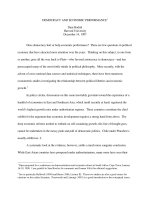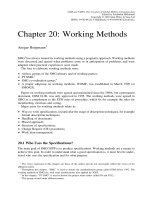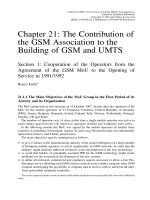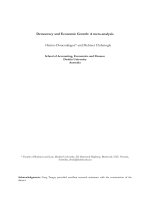Tài liệu Democracy and Economic Performance pptx
Bạn đang xem bản rút gọn của tài liệu. Xem và tải ngay bản đầy đủ của tài liệu tại đây (105.03 KB, 33 trang )
DEMOCRACY AND ECONOMIC PERFORMANCE
1
Dani Rodrik
Harvard University
December 14, 1997
Does democracy hurt or help economic performance? There are few questions in political
economy that have attracted more attention over the years. Thinking on this subject, in one form
or another, goes all the way back to Plato—who favored aristocracy to democracy—and has
preoccupied many of the most fertile minds in political philosophy. More recently, with the
advent of cross-national data sources and statistical techniques, there have been numerous
econometric studies investigating the relationship between political liberties and economic
growth.
2
In policy circles, discussions on this issue inevitably gravitate toward the experience of a
handful of economies in East and Southeast Asia, which (until recently at least) registered the
world’s highest growth rates under authoritarian regimes. These countries constitute the chief
exhibit for the argument that economic development requires a strong hand from above. The
deep economic reforms needed to embark on self-sustaining growth, this line of thought goes,
cannot be undertaken in the messy push and pull of democratic politics. Chile under Pinochet is
usually exhibit no. 2.
A systematic look at the evidence, however, yields a much more sanguine conclusion.
While East Asian countries have prospered under authoritarianism, many more have seen their
1
Paper prepared for a conference on democratization and economic reform in South Africa, Cape Town, January
16-19, 1998. I am grateful to Sam Bowles for comments and Joanna Veltri for editorial suggestions.
2
See in particular Helliwell (1994) and Barro (1996, Lecture II). These two studies are also a good source for
citations on the earlier literature. Przeworski and Limongi (1993) is a good introduction to the conceptual issues.
2
economies deteriorate—think of Zaire, Uganda, or Haiti. Recent empirical studies based on
samples of more than 100 countries suggest that there is little reason to believe democracy is
conducive to lower growth over long time spans.
3
Neither is it the case that economic reforms
are typically associated with authoritarian regimes (Williamson 1994). Indeed, some of the most
successful reforms of the 1980s and 1990s were implemented under newly-elected democratic
governments—think of the stabilizations in Bolivia (1985), Argentina (1991), and Brazil (1994),
for example, or of the Polish transition from socialism.
Should we be agnostic then about the economic implications of democracy? Since civil
liberties and political rights have intrinsic value independent of their economic consequences, it is
good to know that fledgling democracies do not necessarily face any tradeoffs. But there is more
to be said on behalf of democracy.
As I will demonstrate in this paper, democracies perform better than authoritarian regimes
in a number of respects which have received scant attention to date. I will show four results in
particular:
1. Democracies yield long-run growth rates that are more predictable.
2. Democracies produce greater stability in economic performance.
3. Democracies handle adverse shocks much better.
3
Helliwell (1994) and Barro (1996) try to control for the endogeneity of democracy in estimating the effect of the
latter on growth. Helliwell finds that democracy spurs education and investment, but has a negative (and
insignificant) effect on growth when investment and education are controlled. On balance, he finds no “systematic
net effects of democracy on subsequent economic growth.” Barro finds a non-linear relationship, with growth
increasing in democracy at low levels of democracy and decreasing in democracy at higher levels. The turning
point comes roughly at the levels of democracy existing in Malaysia and Mexico (in 1994), and somewhat above
South Africa’s level prior to its transition. A more recent paper by Chowdhurie-Aziz (1997) finds a positive
association between the degree of non-elite participation in politics and economic growth. See also Tavares and
Wacziarg (1996) who estimate a system of simultaneous equations and find a positive effect of democracy on
growth through the channels of enhanced education, reduced inequality, and lower government consumption.
3
4. Democracies pay higher wages.
The first of these implies that economic life is less of a crap shoot under democracy. The second
suggests that, whatever the long-run growth level of an economy, there is less instability in
economic outcomes under a democratic regime than there would be under an autocracy. The
third finding indicates that the presence of civil liberties and political rights improves an
economy’s capacity to adjust to changes in the external environment. The final point suggests
that democracies produce superior distributional outcomes. Taken together, these results provide
a clear message: a risk-averse individual not blessed with a lot of capital—an individual, that is,
like most of us—is considerably better off living in a democracy.
The bulk of this paper is devoted to reviewing the evidence. In the concluding section, I
will suggest some hypotheses that may help account for the economic superiority of democracy.
Democracy and long-run growth
As I mentioned in the introduction, there does not seem to be a strong, determinate
relationship between democracy and long-run growth. A representative scatter plot is shown in
Figure 1 for a sample of about 90 countries. The figure shows the partial relationship between a
country’s level of democracy and its growth rate of GDP per capita during the 1970-89 period,
after initial income, education, and the quality of governmental institutions are controlled.
Democracy is measured on a scale of 0 to 1, using the Freedom House index of civil liberties and
political rights.
4
The slope of the partial regression line is virtually zero.
5
4
See Barro (1996) for a discussion of this index and comparison with others.
5
Introducing a quadratic term in democracy yields the pattern of coefficients found in Barro (1996), but neither
term is statistically significant.
4
Looking at individual cases, it becomes quickly evident why this is so. Among high-
growth countries, Taiwan, Singapore, and Korea rank low in terms of democracy, this being the
source of the conventional wisdom among policymakers reported above. But some other
countries, Botswana and Malta in particular, have done equally well or even better under fairly
open political regimes. (Note that the rankings in this figure have to be interpreted relative to the
benchmarks established by the presence of the other controls in the regression.) Poor performers
can similarly be found at either end of the democracy spectrum: South Africa and Mozambique
have done poorly under authoritarian regimes, the Gambia and Jamaica under relatively
democratic ones.
Hence mean long-run growth rates tend not to depend on political regime type. A
different question is whether democracy is the safer choice in the following sense: is the cross-
national variance in long-run growth performance smaller under democracies than it is under
autocracies? Since mean growth rates do not differ, a risk-averse individual would
unambiguously prefer to live under the regime where expected long-run growth rates cluster more
closely around the mean.
I first divide the country sample into two roughly equal-sized groups. I call those with
values of the democracy index less than 0.5 “autocracies” (n=48), and those with values greater
or equal to 0.5 “democracies” (n=45). The top panel in Table 1 shows the coefficients of
variation of long-run growth rates, computed across countries for the 1960-89 period, for the two
samples. The first row shows the unconditional coefficients of variation, without any controls for
determinants of growth rates. The second row displays the conditional version of the same,
where the variation now refers to the unexplained component from a cross national regression
(separate for each sample) with the following control variables: initial GDP per capita, initial
5
secondary school enrollment ratio, and regional dummies for Latin America, East Asia, and sub-
Saharan Africa. I find that the coefficient of variation (whether conditional or unconditional) is
substantially higher for autocracies than it is for democracies.
Since countries with authoritarian regimes tend to have lower incomes, perhaps this result
reflects the greater randomness in the long-run growth rates of poor countries. To check against
this possibility, I divided countries differently. First, I regressed the democracy index on income
and secondary enrollment levels across countries (R
2
= 0.57). Then I regrouped my sample of
countries according to whether their actual democracy levels stood below or above the regression
line. Countries above (below) the regression line are those with greater (less) political freedoms
than would be expected on the basis of their income and educational levels. In the bottom panel
of Table 1, these two groups are labeled “high democracy” (n=49) and “low democracy” (n=44)
respectively. The coefficients of variation for long-term growth rates are then calculated for each
group in the same way as before. Our results remain qualitatively unchanged, although the gap
between the two groups shrinks somewhat: the coefficient of variation is smaller in countries with
greater political freedoms (where “greater” now refers to the benchmark set by the cross-national
regression relating democracy levels to income and education).
The bottom line is that living under an authoritarian regime is a much riskier gamble than
living under a democracy.
Democracy and short-term performance
A point similar, but not identical, to the one just discussed was anticipated by Sah (1991),
who argued that de-centralized political regimes (and democracies in particular) should be less
prone to volatility. The rationale behind this idea is that the presence of a wider range of
6
decision-makers results in greater diversification and hence less risk in an environment rife with
imperfect information. Note that this argument is about short-term volatility in economic
performance, and not about the dispersion in long-term growth rates which was the focus of the
previous section.
To determine the relationship between regime type and volatility in short-run economic
performance, I focus on three national-accounts aggregates: (a) real GDP; (b) real consumption;
and (c) investment. (All data are from the Penn World Tables, Mark 5.6.) In each case, volatility
is measured by calculating the standard deviation of annual growth rates of the relevant aggregate
over the 1960-89 period (more accurately, by taking the standard deviation of the first differences
in logs). Then each measure of volatility is regressed on a number of independent variables,
including our measure of democracy. The other independent variables included are: log per-
capita GDP, log population, exposure to external risk, and dummies for Latin America, East Asia,
sub-Saharan Africa, and OECD.
Table 2 shows the results. The estimated coefficient on the measure of democracy is
negative and statistically significant in all cases. A movement from pure autocracy (democracy =
0) to pure democracy ( =1) is associated with reductions in the standard deviations of growth
rates of GDP, consumption, and investment of 1.3, 2.3, and 4.4 percentage points, respectively.
These effects are fairly sizable. Figure 2 shows a partial scatter plot which helps identify where
different countries stand. Long-standing democracies such as India, Costa Rica, Malta, and
Mauritius have experienced significantly less volatility than countries like Syria, Chile, or Iran,
even after controlling for country size and external shocks.
Moreover, as the last column of Table 2 shows, causality seems to run directly from
regime type to volatility (rather than vice versa). In this column I have used secondary enrollment
7
ratio as an instrument for democracy (in addition to the other independent variables mentioned
earlier). This variable has all the properties of a desirable instrument, as it is well correlated with
democracy but virtually uncorrelated with the error term from the OLS regression. With
democracy instrumented in this fashion, the estimated coefficient actually doubles in absolute
value.
The evidence strongly suggests, therefore, that democracy is conducive to lower volatility
in economic performance.
Democracy and resilience in the face of economic shocks
The late 1970s were a watershed for most developing economies. A succession of
external shocks during this period left many of them in severe payment difficulties. In some cases,
as in most of Latin America, it took almost a decade for macroeconomic balances to be restored
and for growth to resume. The question I now pose is whether democratic and participatory
institutions helped or hindered adjustment to these shocks of external origin.
The main thing I am interested in explaining is the extent of economic collapse following
an external shock. In another paper (Rodrik 1997a), I have explored how social cleavages and
domestic institutions of conflict management mediate the effects of shocks on economic
performance. Here I focus on the role of democratic institutions specifically.
In a recent review of the growth experience of developing countries, Pritchett (1997) has
looked for breaks in trend growth rates. These breaks tend to coalesce around the mid- to late-
1970s, with 1977 as the median break year. (See the appendix for data on individual countries.) I
use the difference in growth rates before and after the break as my dependent variable.
8
The basic story in Rodrik (1997a) is that the adjustment to shocks will tend to be worse in
countries with deep latent social conflicts and with poor institutions of conflict management.
Consequently, such countries will experience larger declines in growth rates following shocks.
These ideas are tested by regressing the change in growth on indicators of latent conflict and on
proxies for institutions of conflict management (in addition to other variables
6
). Figure 3 displays
a sample partial scatter plot, showing the relationship between ethnic cleavages and the growth
decline. Controlling for other variables, there is a systematic relationship between these two:
countries with greater ethnic and linguistic fragmentation experienced larger declines in economic
growth.
Our interest in democratic institutions in this context derives from the idea that such
institutions provide ways of regulating and managing social conflicts through participatory means
and the rule of law, and hence dissipate the adverse consequences of external shocks. To test this
hypothesis, we check to see whether our measure of democracy—this time restricted to the 1970s
only, to avoid possible reverse-causality complications—is related to changes in growth rates
subsequent to the shocks. The partial scatter plot shown in Figure 4, covering 101 countries,
suggests a clear affirmative answer. Countries with greater civil liberties and political rights
during the 1970s experienced lower declines in economic growth when their trend growth rate
changed. The relationship is highly significant in statistical terms; the t-statistic on the estimated
coefficient on democracy is 3.53, with a p-value of 0.001. Figure 5 shows the results when sub-
Saharan African countries are excluded from the sample. The reason to exclude these is both
6
Each regression in this paper includes the following variables on the right-hand side in addition to those
specifically discussed: log GDP per-capita in 1975, growth rate prior to break year, measure of external shocks
during the 1970s, ethno-linguistic fragmentation (elf60), and regional dummies for Latin America, East Asia, and
sub-Saharan Africa.
9
concern with data quality and the possibility that the relationship is driven by a few African
countries with extreme values. But the relationship holds just as well in the restricted sample: the
partial slope coefficient is virtually unchanged and the t-statistic is almost as high (3.32). As these
two figures show, the hardest hit countries tended to be those with few political liberties (relative
to what would be expected of countries at their levels of income), such as Syria, Algeria, Panama,
and Gabon. Countries with open political regimes, such as Costa Rica, Botswana, Barbados, and
India, did much better.
These results are perhaps surprising in view of the common presumption that it takes
strong, autonomous governments to undertake the policy adjustments required in the face of
adversity. They are less surprising from the perspective articulated above: adjustment to shocks
requires managing social conflicts, and democratic institutions are the ultimate institutions of
conflict management.
To probe the issues more deeply, I investigate the relationship between declines in growth
and three other aspects of political regime: (a) the degree of institutional (de jure) independence
of the executive; (b) the degree of operational (de facto) independence of the executive; and (c)
the degree to which non-elites can access political institutions. These three variables come
originally from the Polity III data (see Jaggers and Gurr, 1995), and have been re-coded on a
scale of 0 to 1 for the purposes of the current exercise. As before, I use the averages of the
values reported for each country during the 1970s. The appendix lists the underlying data. Note
that these three indicators are correlated with the Freedom House measure of democracy (which I
have been using up to this point) in the expected manner: independence of the executive tends to
be lower in democracies, and avenues of non-elite participation are larger. But there are
interesting exceptions. The United States, for example, ranks highest not only on the democracy
10
index, but also in the degree of institutional (de jure) independence of the executive. Other
democracies with relatively autonomous executives (de jure) are France, Canada, and Costa Rica.
By contrast, South Africa is coded as having had (during the 1970s) little democracy and little
executive autonomy.
A nagging question in the literature on political economy is whether an insulated and
autonomous executive is necessary for the implementation of economic reforms.
7
This question is
somewhat distinct from the question about democracy proper, since, as the examples just
mentioned illustrate, one can conceive of democratic systems that nonetheless have well-insulated
executives. Therefore the Polity III indicators are particularly relevant.
The results shown in Figures 6-8 are again somewhat surprising—at least when
approached from the technocratic perspective. I find that more significant growth declines are
associated with greater institutional and operational independence of the executive and lower
levels of political access by non-elites.
8
The estimated coefficients are statistically highly
significant in all cases. Therefore, not only do we not find that executive autonomy results in
better economic management, the results strongly suggest the converse: political regimes with
lower executive autonomy and more participatory institutions handle exogenous shocks better!
9
This might be part of the explanation for why democracies experience less economic instability
over the long run (as demonstrated in the previous section).
7
This literature is briefly surveyed and evaluated in Rodrik (1996).
8
Moreover, the estimated signs on these variables remain unchanged if democracy is entered separately in the
regression.
9
The finding on political participation echoes the argument in Isham et al. (1997) that more citizen voice results in
projects with greater economic returns.
11
Democracy and wages
10
Finally, I turn to distributional issues. I will provide evidence on the distribution of
enterprise surplus in the manufacturing sectors of a broad range of countries. In particular, I will
show that there is a robust and statistically significant association between the extent of
democratic rights and wages received by workers, controlling for labor productivity, income
levels, and other possible determinants. The association exists both across countries and over
time within countries (i.e. in panel regressions with fixed effects as well as in cross-section
regressions).
My dependent variable is the average level of dollar wages in manufacturing.
11
As is to be
expected, labor productivity (manufacturing value added, MVA, per worker) turns out to be the
main determinant of wage differences across countries. But other variables play a role as well, as
shown in column (1) of Table 3. I find that controlling for labor productivity, higher wages are
associated with higher levels of GDP per capita and with higher levels of consumption prices.
They are also associated with greater democracy.
12
The estimate in column (1) suggests a statistically highly significant (p-value < 0.000) and
sizable impact from democratic institutions. Going from the level of democracy in Iraq (0) to that
in the U.S. (1) is associated with an increase in wages of 60 percent, holding all else constant.
Somewhat more realistically, moving from Mexico’s democratic level (0.5) to that of the U.S. is
10
This section draws heavily on Rodrik (1997b).
11
The data come from UNIDO, via the World Bank’s Labor Market Data Base (see Rodrik 1997b for more details
on data sources). I am grateful to Martin Rama for making the data available.
12
associated with an increase of 30 percent. (Note that the panel estimates reported later would
lead us to reduce these impacts by half.)
The partial scatter plot shown in Figure 9 gives a visual sense of the results. We notice
that countries with greater democratic freedoms than would have been predicted from their
income levels such as India, Israel, Malta, and Cyprus also have correspondingly higher wages
relative to productivity. Some countries at the other end of the spectrum—lower-than-expected
values for the democracy index and low wages—are Syria, Chile
13
, Saudi Arabia, Turkey, and
Mexico.
Columns (2) through (7) check for robustness by including a number of additional
regressors (regional and country-grouping dummies are included in all the regressions). I first try
some variables that were included in Freeman’s (1994) paper on national wage differentials:
schooling, urbanization, and openness. None of these enters significantly, which is not surprising
since unlike Freeman (1994) I control for labor productivity directly. Next I include a dummy for
oil exporters, which enters with a negative sign (contrary to my expectations) but is again not
significant. Finally, I include two measures of labor rights: the unionization rate and the number
ratified among the ILO’s six basic workers’ rights conventions. Neither is significant by
conventional standards, and the sign on unionization is actually negative. We should not take the
latter result seriously, however, because of the small sample size in the regression where
12
The regressions shown in Table 3 also include a range of regional and country-grouping dummies (see note to
the Table). The estimated coefficients tend to be statistically significant for East Asia and Latin America (and
negative in both cases).
13
The data refer to the 1985-89 period, during which Chile was run by a military dictatorship. Democratic
elections were held in 1989 (see below on the Chilean case).
13
unionization is included (42 countries).
14
The estimated coefficient on democracy remains
virtually unchanged and highly significant in all these regressions.
The final column of Table 3 shows the results of two-stage least squares estimation, with
democracy treated as an endogenous variable. Following the work of Barro (1996), I use
schooling, a dummy for oil exporters, and five-year lagged democracy as instruments. The
estimated coefficient on democracy is still highly significant, and actually larger.
These results are for a cross-section of about 80 countries during the second half of the
1980s. The democracy index is available on a consistent basis for the entire 1970-94 period. The
data on labor costs and productivity are more patchy, but it is possible to construct time series for
a significant number of countries. Therefore, the natural next step is to pool time-series and
cross-section data and use panel techniques to see whether the relationship between democracy
and wages holds up in a panel setting as well. I use five-year averages of the data covering a
maximum of five sub-periods for each country, namely 1970-74, 1975-79, 1980-84, 1985-89, and
1990-94. This gives us a total of 388 observations. (The panel is not balanced since not all
countries have data for all five-year sub-periods.)
I run three types of regressions on the pooled data: OLS with period dummies; random-
effects (also with period dummies); and full fixed-effects (with dummies for both periods and
countries). Note that the fixed-effects methodology is particularly demanding in this context, as it
requires that the effect of democracy on wages be recovered from the relatively few time-series
observations for individual countries. Since wages and MVA/worker are both measured in
current dollars, I run these regressions also in a slightly different form to eliminate any spurious
14
Also, the sign on unionization turns positive when democracy is excluded from the regression, but the coefficient
remains insignificant.









